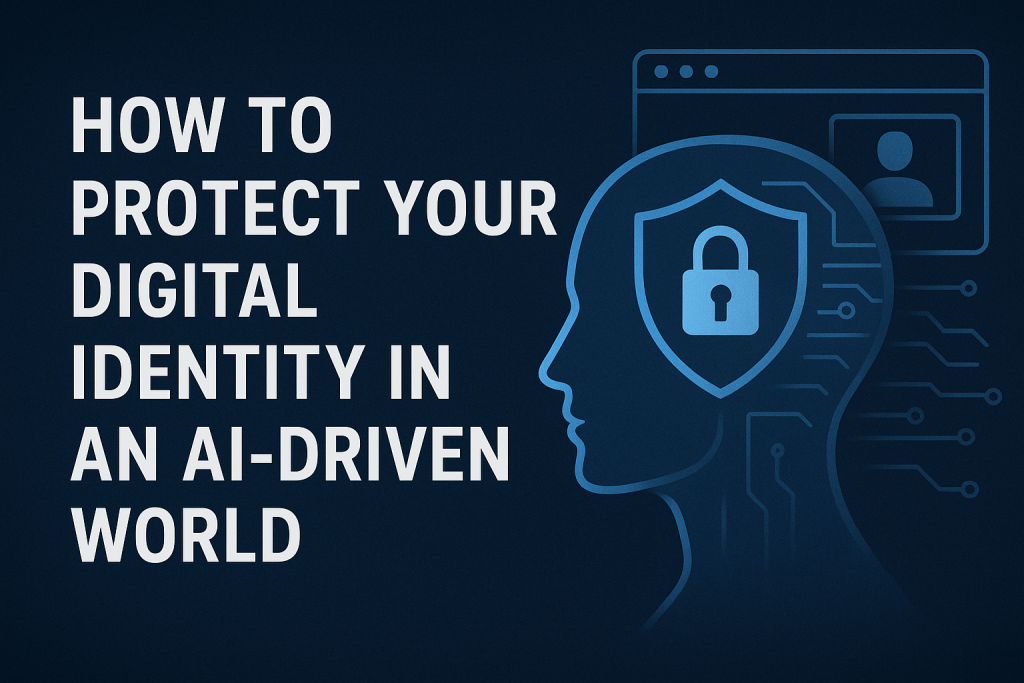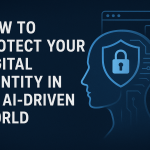In today’s hyper-connected era, artificial intelligence (AI) is transforming the way we live, work, and interact online. From personalized recommendations to automated customer service, AI is making life more convenient. However, this convenience comes with a price: your digital identity is at greater risk than ever before. Cybercriminals are now leveraging AI-powered tools for phishing, identity theft, and data breaches. So, the big question is: how can you protect your digital identity in an AI-driven world?
This blog will walk you through practical strategies, advanced security measures, and best practices to keep your online identity safe.

What is Digital Identity and Why Does It Matter?
Your digital identity includes any personal data that represents you online—such as your name, email address, date of birth, social media profiles, passwords, browsing habits, and even biometric data. Companies and apps use this data to provide personalized services, but if it falls into the wrong hands, the consequences can be devastating.
With the rise of AI-powered cyber threats, criminals can now create realistic deepfakes, fake profiles, and advanced phishing scams. Protecting your digital identity isn’t just a good idea—it’s essential for your security and privacy.
The Growing Risks in an AI-Driven World
AI isn’t just helping businesses; it’s also making cybercriminals smarter. Here are some emerging threats:
- AI-Powered Phishing Attacks: Hackers use AI to craft highly convincing phishing emails that mimic real communication.
- Deepfakes and Identity Fraud: Criminals can create fake videos or voice recordings using your images and voice from social media.
- Data Harvesting by AI Tools: Many AI-powered apps and websites collect large amounts of personal data, often without clear consent.
- Automated Credential Cracking: AI can guess passwords faster than ever, making weak passwords a major liability.
Understanding these risks is the first step toward protecting yourself.
10 Proven Ways to Protect Your Digital Identity
1. Use Strong, Unique Passwords
Weak passwords are the easiest way for hackers to gain access to your accounts. Use complex combinations of letters, numbers, and symbols, and never reuse passwords across multiple accounts. Tools like password managers can help you create and store strong passwords securely.
2. Enable Multi-Factor Authentication (MFA)
Even if your password is stolen, MFA adds an extra layer of security. It typically requires a code sent to your phone or email or a biometric scan. Always enable MFA on sensitive accounts like banking, email, and social media.
3. Beware of Deepfakes and Voice Scams
AI-generated videos and audio clips can impersonate real people. Before taking any action—such as sending money or sharing sensitive information—verify through a secondary method like calling the person directly.
4. Limit Personal Data Sharing
The less personal information you share online, the harder it is for attackers to use it against you. Avoid oversharing on social media and disable location tracking whenever possible.
5. Regularly Monitor Your Digital Footprint
Google yourself and check what information is publicly visible. Remove unnecessary data from old accounts and delete unused profiles. Tools like Have I Been Pwned can help you check if your data has been exposed.
6. Use AI Responsibly
When using AI tools like chatbots or image generators, avoid sharing personal details. Remember that many AI applications store user data to improve their systems.
7. Keep Your Devices and Apps Updated
Cybercriminals exploit outdated software to launch attacks. Enable automatic updates on all your devices to patch security vulnerabilities promptly.
8. Invest in a Good VPN
A Virtual Private Network (VPN) encrypts your internet connection, hiding your IP address and location. This makes it harder for hackers and trackers to monitor your online activity.
9. Secure Your Biometrics
Biometric data like fingerprints and facial recognition are harder to change than passwords. Enable device encryption, and only share biometrics with trusted, reputable platforms.
10. Stay Educated on AI Threats
Cybersecurity is constantly evolving. Follow trusted sources, blogs, and security experts to stay informed about the latest AI-driven scams and security solutions.
How AI Can Help You Protect Your Identity
While AI poses risks, it also offers solutions. AI-driven security systems can detect unusual login patterns, flag suspicious transactions, and even predict cyberattacks before they happen. Many modern antivirus and fraud detection systems rely on AI for real-time protection. Consider using these advanced tools to safeguard your identity.
The Role of Privacy Laws and Regulations
Laws like GDPR (General Data Protection Regulation) and CCPA (California Consumer Privacy Act) are designed to give you more control over your data. Understand your rights and opt out of unnecessary data sharing whenever possible.
Future Outlook: Digital Identity in the AI Era
As AI continues to evolve, so will the methods of cybercriminals. Future threats may include AI-generated identities, smart malware, and automated social engineering attacks. This means your security strategy must also evolve. Using strong authentication methods, encrypted communication, and proactive monitoring will remain key to staying safe.
Final Thoughts
In an AI-driven world, your digital identity is both powerful and vulnerable. By implementing the strategies discussed—such as using strong passwords, enabling MFA, limiting data sharing, and staying updated—you can significantly reduce your risk of identity theft. Remember, cybersecurity isn’t a one-time effort; it’s an ongoing process.






Leave a Reply